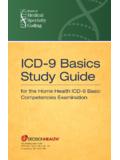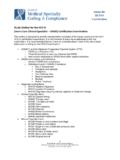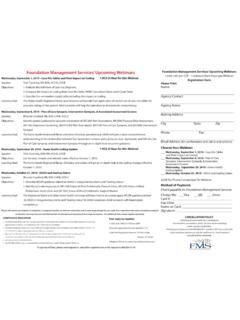Transcription of Practice Questions for the Advanced Coding Specialist ...
1 Practice Questions for the Advanced Coding Specialist urology Credential Examination 1. Which of the following terms describes the area located at the base of the bladder? a. Renal pelvis b. Calyx c. Trigone d. Dome 2. Code the urologist's services: PREOPERATIVE DIAGNOSIS: Advanced carcinoma of the right ureter, morbid obesity POSTOPERATIVE DIAGNOSIS: Same DESCRIPTION OF PROCEDURE PERFORMED: Open nephrostomy with drainage catheter Patient was placed in a lateral position and after adequate general anesthesia, a right flank incision was made to gain access to the retroperitoneal space. Gerota's fascia at the lower pole of the kidney was then incised using a deep knife. The ureter was identified and isolated using Metzenbaum scissors and a small Penrose drain was used to retract the ureter. Additional blunt dissection exposed the renal pelvis where a small incision was made, Kelly forceps were used to tunnel a passageway for the nephrostomy tube.
2 A clamp was used to pull the catheter through the tunnel until the tip was drawn into the renal pelvis. A separate flank incision was made in the skin and the end of the catheter was brought out. A large Penrose drain was placed near the kidney and secured to the skin using silk sutures and the incision used for the surgical approach was closed. a. 52334 b. 50125 c. 50392. d. 50040 3. When two surgeons perform procedures described by one CPT code and both surgeons document their part of the procedure, append a 80 modifier. a. True b. False 4. Removal of a kidney is called a _____. 5. Code the urologist's services: PREOPERATIVE DIAGNOSIS: Urinary calculi POSTOPERATIVE DIAGNOSIS: Same DESCRIPTION OF PROCEDURE PERFORMED: Percutaneous nephrostolithotomy Patient was placed in a lateral position on their left side and 5 mL of lidocaine was injected for local anesthesia.
3 Using fluoroscopy, a suitable posterior calyx of the right kidney was identified and a puncture was made below the 12th rib where a nephrostomy needle was passed into the collecting system. The needle was withdrawn and 3 mL of contrast was used to check for proper placement. Next a 0,035 guidewire (eg, in) was passed into the collecting system and the needle was removed. A fascial incising needle was used to cut the lumbodorsal fascia and the tract was dilated by passing dilating catheters over the guidewire (6F, 8F, and 10F catheters). A 14F nephrostomy catheter was positioned over the guide wire and sutured to the skin. Next a nephroscope was passed through the tube until a single stone measuring approximately X cm was visualized. It was removed with some difficulty using graspers. Another 3 mL of contrast was used to confirm that no additional stones or other obstruction remained, the scope was withdrawn and the patient was returned to recovery room in good condition.
4 A. 50580, 5004551, 76000 b. 50580. 76000 c. 50080, 50395 d. 50081 6. Which of the following medical terms describes an abnormal opening between the bladder and vagina that permits passage of fecal material into the vagina? a. Vesicovaginal fistula b. Rectovaginal fistula c. Rectocele d. None of the above 7. Code the urologist's services PREOPERATIVE DIAGNOSIS: Phimosis POSTOPERATIVE DIAGNOSIS: Same PROCEDURE: Excision of phimotic foreskin This male patient has been experiencing increasing symptoms associated with phimosis such as pain during intercourse and difficult hygiene. After considering his options, he has elected to undergo surgical treatment. After adequate general anesthesia, with the patient in the supine position, several Kelly hemostats were placed at the edge of the prepuce. Next, fine dissecting scissors were used to make a longitudinal incision to the prepuce.
5 This was extended in a circular fashion until it was possible to excise it completely and submit it for pathologic examination. Multiple small bleeders encountered were controlled using electrocautery and the skin edges were reapproximated using sutures. After adequate dressing, the patient was returned to the recovery room in good condition. The foreskin was submitted to pathology. a. 54100 b. 54161 c. 54304, 54100 d. None of the above 8. According to the National Correct Coding Initiative, if a double Jstent is inserted at the same time as another cystourethroscopy or ureteroscopy procedure, each may be reported separately if adequately documented and medically necessary. In order to receive reimbursement for each code, a 59 modifier should be appended to the 52332. a. True b. False End of Practice Questions Answers to Practice Questions 1.
6 C 2. D 3. False 4. Nephrectomy 5. C 6. A 7. B 8. Tru













